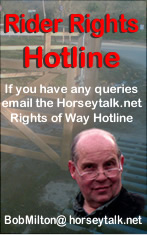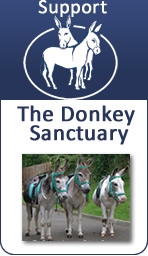
RIDER RIGHTS
Says Naomi Smith
 It is all too possible to round a corner on horseback
and come upon a group of cattle with no prior warning -this WILL result in
a horse being badly spooked at best, bolting at worst -it is only a matter of
time ........... read more
It is all too possible to round a corner on horseback
and come upon a group of cattle with no prior warning -this WILL result in
a horse being badly spooked at best, bolting at worst -it is only a matter of
time ........... read more
Natural England
Maureen Comber writes to Mr David Corner, Director fo Value for Money, DEFRA
-- It seems to me that there is either a conflict of interest between English Law and the ELS, HLS Handbooks, or you and I have been deliberately misled with regard to its interpretation, by Local Authorities, Wildlife Trusts and Natural England?
- The misappropriation of EU funding and its misuse for enclosing our open spaces seems to me something which the National Audit Office should investigate more thoroughly, and this time with the help of Parliament’s Finance Select Committee, because not only is it dishonest misappropriation of public funding, it also runs against the spirit of the law which for centuries has protected our common lands from enclosure.
- There is a further injustice, and waste of public funds initiated by the process above which is this: when these applications are erroneously made to the Planning Inspectorate, they gather objections from the commoners or the general public, more often than not, both of these
Says Maureen Comber
 I have a particular concern that local authorities are not eligible to apply for HLS funding.
I have a particular concern that local authorities are not eligible to apply for HLS funding.
You say in your reply, that Natural England consider local authorities to be eligible to apply for HLS but not ELS funding, as set out in the handbooks. This is causing confusion for me and I must ask if the handbooks override the laws of this land and if so how that can be? My confusion stems from the legal position as stated by Professor Chris Rodgers in his book ‘Contested Common Land’. Here he states:
“Measures under the EC Rural Development Policy are only available for applicants engaged in 'farming', and are therefore inapplicable if a common is not put to an agricultural use. The determining factor here is the economic use to which commoners put their rights, rather than the nature of the rights themselves - only common rights holders who are registered as farmers for the receipt of European Community subsidies can claim agri-environment payments under schemes such as ESA, ELS or HLS. It follows that agri-environment schemes such as HLS have no potential application for the management of 'recreational' commons or those whose primary feature is (paradoxically) their high nature value rather than their value as an agricultural resource." (Rodgers)
That is completely different to the position stated to you from Natural England.
It therefore raises the question of
- how local authorities or Wildlife Trusts can be registered as farmers for common lands which are not and never have been farmed, such as the lowland heaths?
- How Common land, which is owned or vested with local authorities, rather than as a farm registered for receipt of CAP funding, can be said to be eligible for receipt of funds from Natural England for fencing etc?
- Notwithstanding, how millions of pounds from the EU CAP have been granted nationally, on false claims of eligibility and paid out by Natural England?
- Why in the case of SSSI’s, local authorities have been paid money for statutory duty such as clearing and maintenance of public rights of way, gates, fencing, signage etc.?Why does NE think that they can use HLS funding to pay for statutory duty? What specific evidence has been produced to that effect?
This can be seen to be the case in the rights of way and land management representative’s reports for the Agenda, to the Hampshire County Council, Executive Committee for Culture, Recreation and Countryside, which indicated full HLS payments will be received for fencing Yateley Common (para 3. Finance). However the report failed to divulge that this was not specifically the case and is therefore totally misleading. The Deputee’s at that meeting did advise the Chairman that the above statement was inaccurate, but in making his decision to submit the application to the Planning Inspectorate, he chose to ignore their statements!
Simply, it seems to me that there is either a conflict of interest between English Law and the ELS, HLS Handbooks, or you and I have been deliberately misled with regard to its interpretation, by Local Authorities, Wildlife Trusts and Natural England?
You say that Natural England promotes two documents to set out processes to enable any proposal to change the management of a common. However it appears to me that there are no safeguards in place to ensure these have been complied with as suggested in the last paragraph on page 2 of your reply to me? If there had been, we would not be seeing the hundreds of applications submitted to PINS for enclosure of our common land, our wild open spaces which have been strongly protected under existing laws for the last 110 years.
I have attached the deputation I made to the Hampshire County Council Executive Committee on 4th December at Winchester, so that you can see the points of law I am making and how they are being circumnavigated, ignored or broken. Even so the Chairman chose to ignore it and suggested the Planning Inspectorate could sort them out. However the application does not qualify for a decision by PINS, so why waste yet more public money in a planning application that does not have a consensus of local opinion or integrity, other than the self-interest of the landholder, Hampshire County Council. It seems to me that local authorities are relying on the Planning Inspectorate to ratify their applications regardless? It is lamentable that the Commons Commissioners with their thorough experience in these matters, have been abolished.
The misappropriation of EU funding and its misuse for enclosing our open spaces seems to me something which the National Audit Office should investigate more thoroughly, and this time with the help of Parliament’s Finance Select Committee, because not only is it dishonest misappropriation of public funding, it also runs against the spirit of the law which for centuries has protected our common lands from enclosure.
In the light of the above I feel the payments are unlawful and the council should not be or have been accepting them.
There is a further injustice, and waste of public funds initiated by the process above which is this: when these applications are erroneously made to the Planning Inspectorate, they gather objections from the commoners or the general public, more often than not, both of these. This initiates public inquiries. I believe there have been some one hundred or more. The unfairness here is that because the applications are made by Local Authorities or Wildlife Trusts the public purse pays for the application and the PI itself, but the public pay again if they object, but out of their own pockets this time and often for legal expertise which can be very costly! That cannot be good value for the public and it is a huge injustice to the ordinary man who in addition risks the possibility of costs applications. I believe it demonstrates that this whole procedure is wrong for the reasons given, briefly:
- Sec.194 LPA 1925 was written in support of sec 193 of the same Act, whereby public rights of access for ‘air and exercise’ to common lands which came under this section, were granted under the statute.
- Sec.194 is specific in identifying land that had commoners rights before 1926 as being included in sec.193.
- Sec 194 has since been replaced by sec.38 Commons Act 2006. It is clear that public access must not be prevented or impeded and this alone should have prevented these applications for fencing common land from the start.
- The application for the funding to fence the common land by application to Natural England could not be valid, since the CAP funds are for farmers or land managers registered for receipt of EU farming subsidies. Local Authorities and Wildlife Trusts are not so registered particularly where the common land has never been farmed such as on the lowland heaths.
- The Planning Inspectorate should have refused these applications on that basis alone instead of wasting public money by holding public inquiries when the outcome is not feasible in any case. Another huge waste of public money.
In addition, I am also concerned that there will be an adverse effect on the provision of other services within the council, when the money has to be returned as it surely must be? It would interest me to know over what length of time these payments have been made and to whom they have been made, since as the Hon. Sec. of the Broxhead Commoners Association, I know of no commoners who have been in receipt of such funds even though they have been successfully claimed by Hampshire County Council?
My letter to you dated 19th July 2012 also gave a brief resume of a public inquiry concerning a bridleway claim on Broxhead Common. I queried the impartiality of the Planning Inspectorate and its refusal to take into account the problems associated with the misappropriation of 80 acres of this common, as the claimed way runs over it, although outside of the illegally enclosed area. Since what remains of this common land (100 acres), is rented by Hampshire County Council, please may I suggest that an in depths inquiry into the financial obligations initiated by them be made, as it appears that serious maladministration is occurring and has been for decades.
I should be grateful if all of these matters could be investigated further please.
Says Linda Wright
 We moved to a Shropshire location a year ago having surveyed the local OS
map and noted the significant number of bridleways around the property.
Sadly the map appears a total fiction. Scarce any of the bridleways are
usable ........... read more
We moved to a Shropshire location a year ago having surveyed the local OS
map and noted the significant number of bridleways around the property.
Sadly the map appears a total fiction. Scarce any of the bridleways are
usable ........... read more





